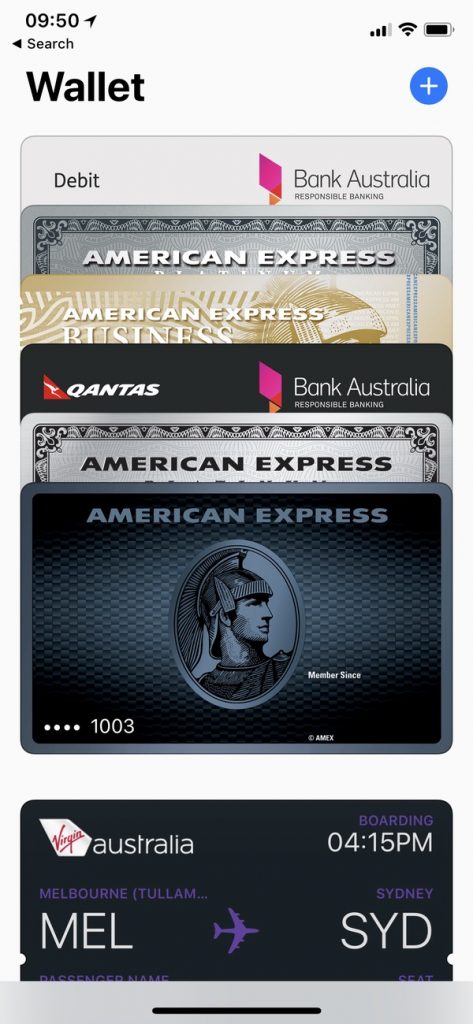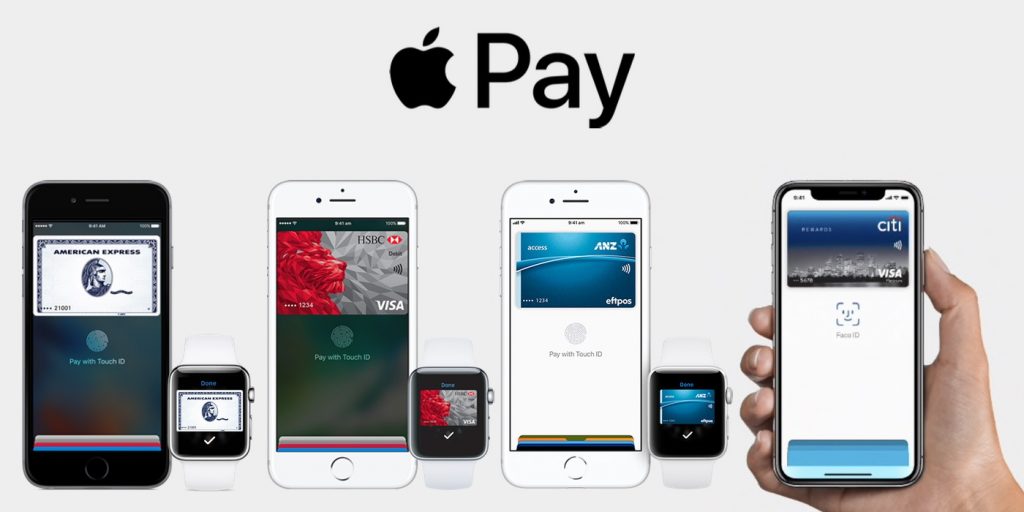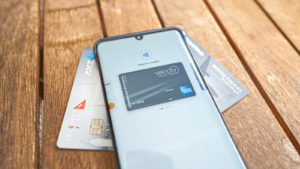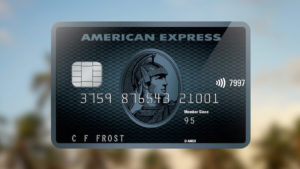Apple Pay—and its competitors at Google—is helpful for people in the frequent flyer points game, with easier payments (as long as you have your device) and you’ll still earn rewards just as you would if you used the physical credit or debit card.
You also benefit from increased security and convenience, and can ‘carry’ more cards with you to ensure you have the right card for the right payment in your digital wallet.
The goal of this guide is to walk you through just what Apple Pay is, who it is available to, how it affects your rewards programs, and a general look at other features of the platform, including security.
If you are an Android user, we have a separate guide for you.
Which cards can be used?

Apple Pay is currently available to customers of:
- American Express
- ANZ (also offers option to withdraw cash from eligible ATMs with your smartphone with ANZ Wallets@ATM)
- Bank of Melbourne
- BankSA
- Bankwest
- BOQ Specialist
- Citibank
- CommBank
- HSBC
- Macquarie
- NAB
- Qantas Money
- St.George
- UBank
- Westpac
- a number of smaller financial institutions, including credit unions
How does Apple Pay actually work?
Apple Pay is a method of payment whereby you link your credit card to the Wallet app in your Apple device and use the phone to purchase items. This avoids you having to open your wallet, or worse still, remember which card is in which wallet or purse.

It can be used anywhere you see the contactless or Apple Pay symbols, as shown to the right. These days, that’s pretty much any retailer with EFTPOS facilities.
As someone who has multiple cards in Apple Pay, you might find it incredibly convenient.
For example, American Express allow you to hold two American Express credit cards plus a charge card. Factor in a points-earning Visa such as ANZ Frequent Flyer Black or HSBC Qantas Platinum, and say you also happen to carry a business card then you’ll have a mix of points-earning cards to choose from, some of which you may only use for contactless payments infrequently.
Using a digital wallet such as Apple Pay, you now theoretically have the ability to select from multiple cards and decide which one will best suit your current purchase, depending on the points-earning potential of the transaction.
For example, you may choose to use Platinum Edge for supermarket spend and your Explorer for a solid points earn on everything else.
How does Apple Pay work with my rewards programs?
If you do have an eligible card, your ability to earn points through your card remains unchanged. Whether you use Apple Pay or carry out a traditional transaction with your physical card, your rate of points earning will remain exactly the same.
One future goal for Apple’s Wallet is for store loyalty programs to eventually link into Apple Pay, as has already happened with the Walgreens pharmacy chain in the US. Whilst they are not linked to frequent flyer programs, they will ensure greater adoption of the platform across the board, and innovation overseas will be a blueprint for what comes to Australia in due course.
How do I set up and use Apple Pay?
Setting up Apple Pay on your device
Any of the newer iPhones, Apple Watches and iPads are ready to be used with Apple Pay. Check the Apple website to see if your device is included.
If you don’t have this card set up within your iTunes account, simply tap the + sign in Wallet and add your card’s details.
Using an iPhone at a point of purchase
iPhone models from the iPhone 6 up have been set up with a function called ‘Near Field Communication’ (NFC). Consumers simply need to hold their iPhone near a contactless card reader and authorise via Touch ID or Face ID.
Alternatively, you can double-click the Home button and go to the Wallet app.
Using an Apple Watch at a point of purchase
Apple Watch owners simply need to double-click the side button on their watch and hold it near the contactless card reader. A tap and beep then confirm the payment has been sent.
Using Apple Pay in Safari
If you use Safari as your web browser on your iPhone, you can expedite the purchase process with Apple Pay.
If you are browsing on your Mac or iPad and have your iPhone or Apple Watch next to you, then you can complete the process with your handheld device.
If you are lucky enough to have the MacBook Pro with Touch ID, then you can verify your identity that way.

Using Apple Pay within apps
Depending on support from the app developer, you can also use Apple Pay for in-app purchases, for example, with Deliveroo, making the payment very simple.
How secure is Apple Pay?
As soon as anyone mentions touchless technology, it’s only a matter of time before someone else sprouts the associated dangers (some perceived and some real). However, this is what sets Apple Pay apart from using a physical card.
When using a credit card, your name and credit card number are shared and used across multiple platforms. Apple Pay removes the necessity for your name or credit card details to appear anywhere.
Apple Pay creates a Unique Account Device Number (UADN) which it assigns, encrypts and securely stores in ‘secure element’, a dedicated chip in your device.
When you make a purchase, the UADN along with a transaction-specific dynamic security code is used to process the payment, thereby bypassing the need for your name or details to be shared with anyone.
Should the unfortunate situation arise that you either lose your phone or have it stolen, you are able to use Apple’s Find My iPhone website or app, which can track, delete or suspend both payment details and all other information on your device.
You will no longer have to waste time on the phone to suspend or cancel a card that you have lost at home. You can locate it remotely, or suspend the payment feature until you have found your device. Replacement card details from some providers also automatically find their way into Apple Pay without you needing to set them up again.
Why are some bank partners missing?
Other banks are likely not on Apple Pay due to commercial decisions on their end. I personally love the platform and suspect that many consumers would now factor digital payments into their banking decisions.
It’s interesting that banks are still (not) using Apple Pay as a commercial lever for their own ends. Rollout in Australia had been hindered by stalled negotiations between Apple and some of the big banks, due to a disagreement over payment fees.
ANZ was originally resistant to jumping onboard but joined in April 2016, as did CommBank in January 2019. NAB joined in May 2019 and Westpac in June 2020.
Westpac customers are (until June 2020) left using Fitbit Pay, Garmin Pay or their own Paywear device—all fairly niche products.
You can read more about those options in our guide to Android digital wallets.
Summing up
Consumers have formed strong habits around contactless options and Apple Pay achieves the aim of making transactions easier and more secure for those with access to it.
For points collectors who are heavy credit card users for their day-to-day transactions, the added security should be appealing and the ability to easily switch between different cards at the point of sale is helpful too.
Let’s hope that the other banks extend this service to their customers sooner rather than later.
Supplementary media courtesy Apple and American Express.






Will Apple pay with a linked Amex card work at a payment terminal that only accepts visa, MC and apple pay? …similar to PayPal online.
Or does the linked card in Apple Pay need to be a card type accepted by the payment terminal?
Do you also get charged the credit card transaction fee of the payment terminal when using Apple pay?
Thanks
Access to the new card was seamless, a huge convenience and relief.
Velocity has the Wallet option as well which is done from their website, link sent to phone and follow instructions.
For other loyalty or shop cards, I have started using Stocard.
Added Qantas, Velocity and FlyBuys. Many more to be added soon.
Saves wallet space immensely.
Having lived in the US I still use my US cards sometime. (Can’t beat 3points per USD on restaurants, for instance). And Apple Pay gets over he fact that they are not contactless and require a signature if you use the card but not with Apple Pay.
There’s some good non-credit cards you can add: Woolworths rewards for one and (with certain iphones) the suica transit card that works in Japan. I can’t wait for the day that miki, opal, Medicare and every other piece of plastic become part of the ecosystem. I’m leaving my wallet at home more and more now and can’t wait to leave it at home for good.